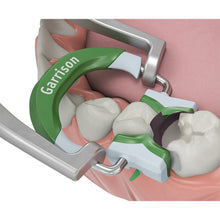Composi-Tight® 3D Fusion™ Ring
More than 20 years of sectional matrix leadership and an incredible amount of feedback from users all over the globe were poured into the design of the new Composi-Tight® 3D Fusion™ rings. All this hard work has resulted in separator rings with significantly improved performance and ease of use.
Curion is proud to be an authorized distributor of Garrison Dental products in Canada. This product is backed by the manufacturer's warranty.

Composi-Tight® 3D Fusion™ Ring
The two main separator rings, short (blue) and tall (orange), are the heart of the new Composi-Tight® 3D Fusion™ system. These are your “go-to” rings and will be used for the majority of restorations.
The world’s first Wide Preparation separator ring (green) makes Composi-Tight® 3D Fusion™ the most versatile and user-friendly sectional matrix system available. The Wide Prep ring greatly simplifies what until now has been one of the most challenging posterior composite restorations. Now you can restore these big preps with confidence knowing that you will achieve excellent contact and contour without having to take extra steps.
BENEFITS
- Get a grip – All Composi-Tight® 3D Fusion™ separator rings incorporate Ultra-Grip™ retention extensions that anchor them securely to virtually any tooth. Fusion rings stay where you place them!
- Stack it up – Tru-Stack™ technology allows placement of the orange ring (tall) over the blue ring (short) for easier MOD and multiple tooth restorations
- Hugs the curves – Soft-Face™ silicone tips with enhanced marginal ridge anatomy hug the matrix band to the tooth for flash free restorations
- It just keeps going – Enhanced durability for extended ring life and greater tooth separation
Basic Section Matrix Technique
How to choose your first Class II restoration case to use a matrix system, and how to use the matrix system during the restoration.
Advanced Sectional Matrix Techniques with Dr. Derek Draft
Advanced sectional matrix techniques for wide preps, MODs, back-to-back, and quadrant Class II restorations.
Composi-Tight® 3D Fusion™ Tall Molar Ring Instructional Video
Composi-Tight® 3D Fusion™ Wide Prep Ring placement
Extra Wide Prep
Learn how to restore an extra wide prep with a sectional matrix system in a few simple steps to get the best restoration possible.
Restoring an MOD
Learn how to restore an MOD with a sectional matrix system in a few simple steps to get the best restoration possible.
Back-to-back Class IIs
Learn how to restore a back-to-back Class II with a sectional matrix system in a few simple steps to get the best restoration possible.
Frequently Asked Questions
No. Any Garrison forceps will work. However, the new Fusion forceps do work better. They have a completely different fulcrum point and tip positioning that make the super-strong Fusion rings easier to open. This is particularly important for people with smaller hands or medical issues with their hands such as arthritis or carpal tunnel syndrome.
Blue Fusion ring (FX400) = Shorter tips for better engagement with short teeth. The blue ring also grips better in challenging locations such as the distal of the canine or on top of rubber dam clamps. The blue ring is also preferred for pedodontic applications.
Orange Fusion ring (FX500) = Taller tip for proper matrix band adaptation on taller teeth. The orange ring is also designed to stack over top of the blue ring without interference for MOD or multiple tooth restorations.
Green Fusion ring (FX600) = Extra wide tips for use on wide restorations where the blue/orange tip may push the matrix band into the preparation.
Fusion rings should be cleaned before sterilization with a soft plastic brush and warm water. Sterilization is NOT a substitute for proper cleaning. If debris has accumulated due to improper cleaning, the use of a scaler or other metal instrument may be needed to gently scrape the debris from the ring tips. Debris does not negatively impact ring performance or reduce ring life; it just looks bad.
Fusion rings should be engaged with a Garrison forceps on the metal portion that is between the plastic loop and plastic tips. DO NOT engage the plastic as you may damage it.
Approximately 400




















